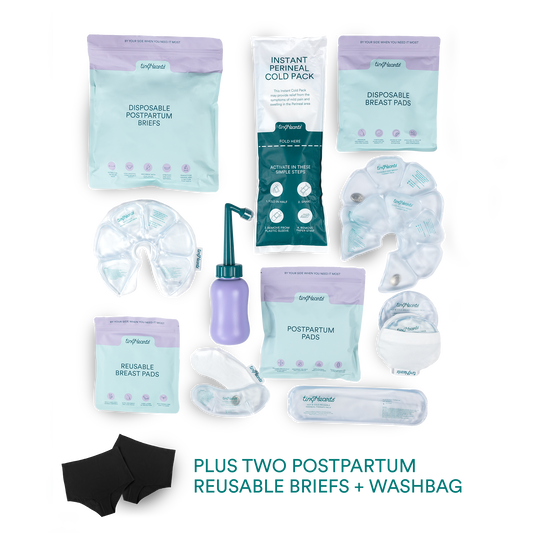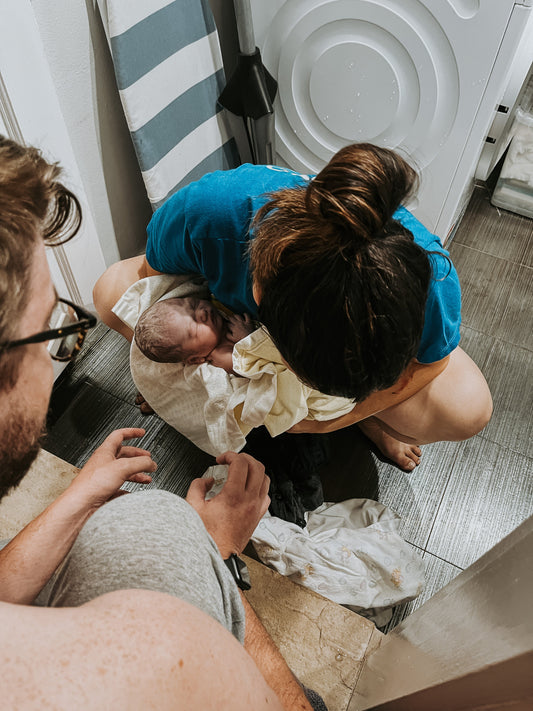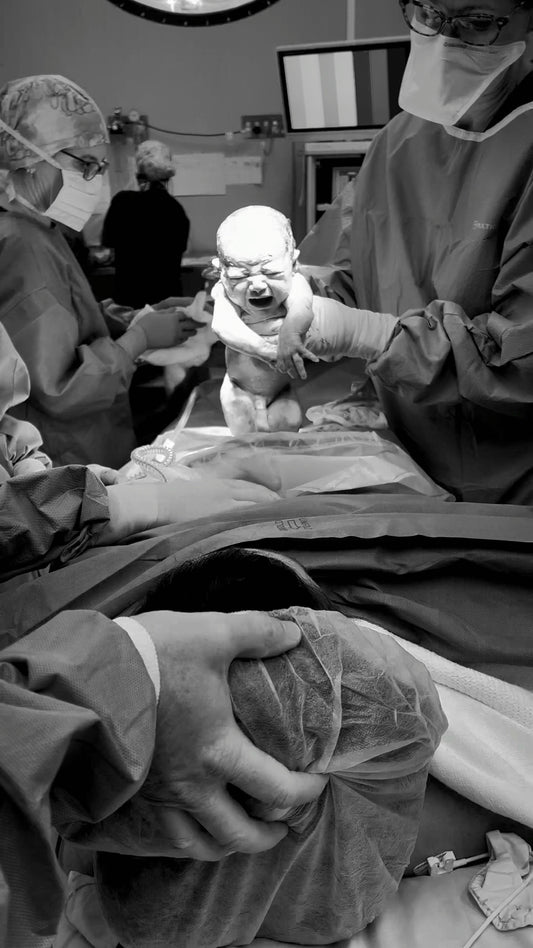One of the first things you'll think about once finding out you're pregnant is, "when am I due?" Throughout your pregnancy, that will very quickly become one of the things you're asked about the most as well. So much focus and emphasis are put on the due date that when a mama watches her due date come and go without bub being born, it can be disheartening and upsetting for some.
A full-term pregnancy is dated anywhere between 37-42 weeks. A study done in 2013 showed that based on their last menstrual period dates:
- 10% of mamas gave birth by 38 + 5
- 25% gave birth by 39 + 5
- 50% gave birth by 40 + 5
- 75% gave birth by 41 +2
- 90% gave birth by 44+ 0
Further research also showed that for first-time mamas, 50% will go into labour and birth their bub by 40+5, while 50% of mamas who have had bubs before will go into labour and birth their bub by 40+3. This means that there's also 50% who won't and instead will pass their due date. These studies showed that the average due date of 40 weeks is more so a guide and is certainly not a true indication of the day bub will be born. But as that date approaches, you might be looking at ways to bring on labour.
Unfortunately, there are no guaranteed ways to put yourself into labour, but there are certainly some things you can try, which I'll discuss below. Some of the strategies below are evidence-based [meaning based on scientific research], and others are wives tails. Before trying to bring on your labour, make sure you're full-term, and your Doctor or Midwife has cleared you to try some of these strategies. If you try these and see any pregnancy red flags, STOP and contact your pregnancy care provider for advice.
Stretch and sweep [Sweeping the membranes]
A Doctor or Midwife can perform a stretch and sweep on a mama who is reaching the end of pregnancy, has not broken her waters and is preparing for a vaginal birth. The exact timing of when it can be performed is based on the hospital policy or personal practice of the Obstetrician. To do this, a vaginal examination is performed on full-term mama's that have no complications. The Doctor or Midwife separates the membranes from the cervix, which causes a release of Prostaglandins [a hormone that helps labour begin]. The prostaglandins make the cervix absorb water, soften and begin to open. It can also help kickstart contractions. Stretch and sweeps reduce the need for induction, particularly for mamas who have had bubs before, don't increase the risk of infection when performed correctly, and reduce the time between starting a formal induction and birth when performed at the start of the induction. However, they are also associated with irregular contractions, pain, vaginal bleeding and may not help bring on or shorten labour for a mama who is having a VBAC. Some Midwives say they will usually only work if your body was ready to labour anyway, and it's important to know that stretch and sweeps don't always work.
Sexual intercourse
I know that being intimate with your partner at 40 weeks pregnant is probably the last thing you feel like doing, but this one can help in two ways. Research suggests that semen contains Prostaglandins. Like I said above, Prostaglandins may help change the cervix. Artificial prostaglandins are actually used in Cervidil [the tape and Prostin gel, which are two of the ways your pregnancy care team may begin to induce your labour. However, these medications contain higher concentrations of prostaglandins than semen, so don't be tricked into thinking they are the same.
The second way it can help is when you orgasm, your body releases Oxytocin. Oxytocin is the love hormone responsible for many things, one of which is contractions. It's thought that the Oxytocin release following an orgasm will help kickstart contractions, leading to labour.
While these theories may have some scientific foundations, a study published in 2001 suggests that the effectiveness of sexual intercourse putting a mama into labour still needs more research to know for sure.
Nipple stimulation/ expressing
A low-risk mama planning a vaginal birth may consider nipple stimulation or expressing from around 36-37 weeks. Similar to sexual intercourse and orgasm, when a mama performs nipple stimulation or expressing [whether by hand or a pump], her body releases Oxytocin. Like I said above, this will stimulate contractions which can help kickstart labour. Sometimes these contractions will fizzle out, but they may also begin to make changes on the cervix. A study in 2015 showed that oxytocin levels were highest in mamas who were onto their third day of regular nipple stimulation, which means this is more of an ongoing strategy rather than a quick fix. It also showed that the minimum breast stimulation time to induce spontaneous labour was 1 hour each day for at least 3 days.
It's also important to know that if you're expressing or stimulating your nipples and you feel a lot of contractions or contractions that are lasting longer than around a minute, you should stop.
Acupuncture/ acupressure
Acupuncture to induce labour should be performed by a qualified professional from 37 weeks. It's when several fine needles are placed in specific places on a mamas body. Acupressure is when a support person [or mama herself] applies pressure using their fingers or thumbs to specific pressure points on the body from 37 weeks to induce labour. Both of these strategies are said to help soften and dilate the cervix and stimulate the uterus to contract. A Cochrane review in 2017 found that acupuncture and acupressure don't appear to reduce the need for a c-section but may increase the readiness of the cervix for labour. However, they found no evidence to suggest acupressure did the same.
Dates
There's quite a lot of research around eating dates during pregnancy. Research suggests that eating around six dates [or approx 70g] per day from 36-37 weeks is said to encourage your cervix to soften and open, leading to more mamas having increased cervical dilation on admission to hospital as well as a shorter first stage of labour.
Researchers also think that eating dates results in your contractions being more effective by helping the oxytocin receptors better respond to the Oxytocin your body naturally releases.
Castor Oil
Evidence supports that castor oil can increase the chances of you going into labour within 24 hours if you're at or over 40 weeks pregnant. Castor Oil is most effective if you've had a vaginal birth before. However, Castor oil it's also a strong laxative and associated with nausea in labour, so when you're considering this one, have a chat with your pregnancy care provider first. In saying that, a Cochrane review conducted in 2013 showed no difference in the c-section rate, rates of vacuum or forceps being used for birth, meconium-stained liquid, or APGAR scores less than 7 at 5 minutes.
Spicy food
The theory behind this one is that spicy food makes the intestines contract, which can sometimes irritate the uterus. The evidence is anecdotal though, meaning there's no scientific research to back it up, so be aware that instead of contractions, you might end up with heartburn.
Pineapple
When I was trying to bring on my labours, every second person suggested eating pineapple. The theory behind pineapple is based on an enzyme it contains called bromelain. Bromelain is said to work on the cervix by softening it. It's also said for pineapple to work, a mama needs to eat huge amounts of pineapple, predominately the core.
There's also minimal evidence on how effective eating pineapple to induce labour is, but one study in 2016 found that putting pineapple extract directly on uterine tissue caused the tissue to contract. However, it's also not known if eating pineapple has the same effect.
Evening Primrose Oil
Evening Primrose Oil are capsules that can be taken orally or vaginally in the last few weeks of pregnancy. Very limited research suggests taking Evening Primrose Oil vaginally and laying down for a period of time afterwards may work to reduce the length of early labour and helps to soften and open the cervix in preparation for labour, however taking Evening Primrose Oil orally was said to be less effective. Keep in mind that more research needs to be conducted around this and that you should chat to your Doctor or Midwife before taking any new medication in pregnancy.
Exercise
While exercising itself may not induce labour, it can help position bub and encourage them to move down in the pelvis. Gentle exercise like walking, swimming or yoga throughout your pregnancy also promotes endorphins and minimises Adrenaline, which is great for letting Oxytocin flow. Bouncing on the birth ball does a similar thing; help position bub for birth and can help move them downwards. That helps by allowing bub to put pressure on your cervix [which makes it soften and open, and can stimulate contractions].
Curb walking
Curb walking is when a mama walks along the curb with one foot on the gutter and one foot on the road. Once you've done it on one leg, walk the other way back up the street to do it on the other leg.
Curb walking opens your pelvis, giving bub more room to come down towards the exit, allows bubs head to put increased pressure on the cervix [making it soften, thin and dilate] and uses gravity to move bub down. While curb walking may not bring on labour itself, it can help with positioning bub into the best position for birth and apply pressure to the cervix.
Raspberry leaf tea
Anecdotal evidence suggests that drinking raspberry leaf tea before birth can shorten labour thanks to a stringer uterus, which can also prevent a big bleed after birth. However, evidence suggests more evidence is needed to be sure what it does, side effects, safety data and if it actually works the way some people say it does.
These are the most common suggested ways to bring on labour naturally. If you're feeling up to it, are full-term and have been given the green light by your pregnancy care provider, give these a go and see how you go! They might work, but keep in mind that they also might not. Put your feet up, relax and try to soak in these last moments before bub arrives. You're so close, and before you know it, you'll have your sweet little babe in your arms. Goodluck, mama! ✨







